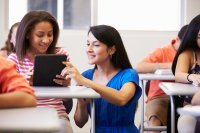Getting Rid of the Lecture Bottleneck
Doing away with lectures in math class means that students can work at their own pace while teachers differentiate instruction.
Your content has been saved!
Go to My Saved Content.When I first started teaching high school math, I followed the common “I do, we do, you do” pedagogical formula to stay afloat. Each day I used a simple framework:
- Opening: Get everyone’s attention
- Direct instruction: Deliver a 10–20 minute lecture to the whole group
- Guided practice: Work through a problem as a whole group
- Independent practice: Give the students an assignment to work on individually
- Closing: Administer an exit ticket to assess learning
I worked tirelessly to make sure the class would operate like a well-oiled machine. But I would always stumble at the same point in the process: the lecture. I would dread the beginning of every class period. Once the lecture began, it quickly became clear that I was only talking to a small percentage of the students in front of me. Most found the lecture to be too fast to understand or too slow to keep them engaged.
I would employ a litany of procedural tricks to stimulate engagement, all of which were bandages that couldn’t repair a fundamentally flawed structure.
The Lecture Is the Problem
In business, a bottleneck is defined as a point of congestion that leads to inefficient production and an increase in associated costs. For years, my traditional model of teaching was largely ineffective because my lecture was a major bottleneck in the production of student learning.
Let’s first address the inefficiency of a lecture. The lecture is a bottleneck for several reasons—one size does not fit all in learning; there’s no replay, rewind, or fast-forward button in a lecture; and a large group of students are all dependent on one teacher to access learning.
A basic principle of good teaching is recognizing that each student is truly unique. Students learn content in a variety of ways at sometimes vastly different paces. However, when class begins in a traditional classroom, these highly diverse students are frozen. Students ready to move forward must patiently wait for the teacher to deliver the content, even though they may not need it. Meanwhile, students with skill deficiencies and truancy issues must compliantly listen to a lecture that does not address their needs as they wait to inform the teacher that nothing made sense. If a student misses all or a portion of the lecture, the opportunity is lost.
The lecture is not only inefficient but also strips students of the opportunity to develop 21st-century skills that are critical to succeeding in adulthood. When students have to wait for a lecture to move forward, they become conditioned to believe that learning happens to them. The responsibility to access, internalize, and apply new information largely falls on the shoulders of the teacher. The students are not given the freedom to become self-directed learners who are responsible for managing their own time.
The Advantages of Blended Learning
In my classrooms now, I build instructional videos to replace my lectures. To do so, I simply take the very same PowerPoint I would previously have used to lecture and record over it using a screencasting program. While it was initially intimidating, creating instructional videos is pretty simple and does not require much tech savvy. I then upload my video to a program (e.g., Edpuzzle) that allows me to embed questions to use as checks for understanding. You can watch my lesson “Independent vs. Dependent Variables” to get a sense of how these videos work and what they look like.
Once the lecture bottleneck is removed, teachers have the opportunity to rethink many of the other rigid constraints that have defined most instructional delivery models. Without this bottleneck, teachers can facilitate classrooms where students pace themselves, where they have to show mastery in order to progress, and where discussions between the teacher and an individual student are targeted and data driven, based on that student’s needs and capabilities.
In lecture-free classrooms, students no longer need to work at a predetermined pace that has been established without regard for their unique needs. Moreover, lessons don’t need to be chunked to fit arbitrary scheduling demands that require each lesson to be the same length. Instead, teachers can facilitate a self-paced environment where students are always appropriately challenged and teachers differentiate for all students.
Once a self-paced environment is established, teachers can move to mastery-based grading. It is the expectation of uniform pacing that forces teachers to give students partial credit and completion grades. When the lecture bottleneck is removed and students have the freedom to self-pace, teachers have the flexibility to expect mastery before students move forward. Teachers can use the entirety of their class time facilitating discussions around revisions, reassessments, and reflection as students tackle road bumps on their journey to authentic understanding.
The result is a data-driven and student-centered classroom that honors the importance of personalizing learning to meet the unique needs of each student. After restructuring my classroom, I saw major shifts in student learning and self-efficacy. Not only were students mastering more skills than before, but they were able to reflect on their journey through the learning process.
More importantly, there was a noticeable decrease in anxiety and increase in confidence. Students were no longer stressed about coming to class because they knew they were going to pick up where they left off and were confident they would be given the time they needed to truly internalize the content.
